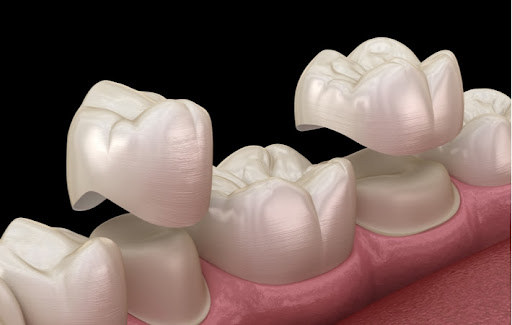When teeth are damaged, they require treatment to restore strength and function. Depending on the damage, this may be a dental filling or a dental crown. If you need a crown for one of your teeth, what should you expect during the procedure?
Continue reading to learn more about dental crowns, including what they are, the materials available, and how this procedure works.
What is a Dental Crown?
Damage can happen to your teeth over time from tooth decay, injuries, or other causes. This damage can cause your teeth to lose their shape, size, and strength. A dental crown is a cap that covers a tooth to restore its function and improve its appearance.
A crown completely covers a tooth, looking natural when it’s cemented into place. A patient may need a dental crown for a variety of reasons.
When Do You Need a Dental Crown?
A dentist usually recommends a dental crown to protect a damaged tooth. Your tooth may be cracked, broken, or worn down, leaving it at risk of further complications if not addressed. Your dentist may give you a dental crown for one of the following conditions:
- To restore a broken or worn down tooth
- To protect a weakened tooth from breaking
- To hold a cracked tooth together
- To cover a tooth with a large filling
- To hold a dental bridge in place
- To cover a dental implant
- To cover a misshapen tooth
- To make a cosmetic change
Depending on the reasons for the dental crown and the tooth’s location, your dentist will recommend a suitable material for the crown. There are several types of materials for dental crowns.
Different Types of Dental Crowns
If you’re receiving a crown, your dentist will recommend the material they think is best to improve the condition of the tooth. Possible materials for your dental crown include:
Metal Crowns
Metal crowns are long-lasting and durable because they consist of gold alloy materials. They won’t chip or break and are unlikely to wear down the natural teeth near the crown. They’re typically used in the back teeth as they may show when eating, smiling or laughing.
Porcelain Crowns
Porcelain crowns look like natural teeth. They’re more brittle than other materials and may chip if you grind or clench your teeth. Your dentist will assess whether or not this is something you are at risk of.
Composite Crowns
Like porcelain, composite crowns look similar to natural teeth. They are more durable than porcelain crowns but may wear down more easily from chewing. They can stain due to tooth brushing removing the polished surface of the crown. These are only used on front teeth to repair minor damage or spacing between the teeth.
Porcelain-Fused-to-Metal Crowns
Porcelain-fused-to-metal crowns may be recommended for molar teeth. The porcelain outer surface may chip, however, the inner metal structure is resistant to damage. This type of crown looks natural, but metal may show at the gumline depending on the crown’s design.
After selecting an appropriate material for your crown, your dentist will begin the procedure. What should you expect during the dental crown process?

The Dental Crown Procedure
If you need a dental crown, you may wonder what to expect during this procedure. A crown usually needs two appointments to complete, one for preparation and another to place the final product.
You should expect the following steps during your dental crown procedure:
Tooth Numbing
Before beginning the procedure, your dentist will numb your tooth and the surrounding area with a local anesthetic.
Preliminary Impressions & Shade
A laboratory creates your crown, but they first need an accurate model of how your teeth fit together. This step may happen digitally or with alginate impressions to create a physical model of your teeth.
Your dentist will then record the colour of your tooth using a shade guide. This step helps create a natural-looking crown that blends in with your regular teeth. If you’re getting a gold crown, you don’t need to determine the shade.
Tooth Preparation
A dental crown covers the entire visible portion of your tooth, so the remaining natural tooth must fit inside the hollow centre of the crown. Preparing for a crown includes removing precise amounts of your tooth.
Final Impressions
After your tooth is shaped, your dentist will create a final impression of this tooth and the surrounding area. This impression helps to make your permanent crown. After the impression is complete, you’ll receive a temporary crown.
Temporary Crown
Your prepared and shaped tooth must stay protected until your permanent crown is ready for placement. A temporary crown acts as a barrier, protecting your tooth from moving and potential damage. It takes around 7 to 10 business days for your permanent crown to be ready.
Cementing Your Permanent Crown
Before placing your permanent crown, your dentist will numb your tooth. After removing the temporary crown and letting the tooth completely dry, your dentist can place the permanent crown. Your dentist will check to see if the fit is appropriate before beginning the cementing process.
They will layer a bonding agent onto the tooth and fill the permanent crown with dental cement. The crown covers the tooth, and your dentist will remove any excess cement. After the dental crown is secure, your dentist will check that your teeth bite together comfortably.
Checking Bite
Your dentist must ensure your new crown fits when your teeth bite together. If there are any issues, adjustments are needed.
Once your dentist believes your permanent crown is set and fitting correctly, your new tooth is ready for use.
Take Care of Your Teeth
Crowns are strong and last approximately 10 years, but only if you take care of them. Remember to brush and floss your crown just like your natural teeth.
Regular dental visits are vital for keeping your teeth and gums healthy. Dental appointments also let your dentist check how your crown is doing.
If you need a dental crown, request an appointment and see how your dentist can help.








